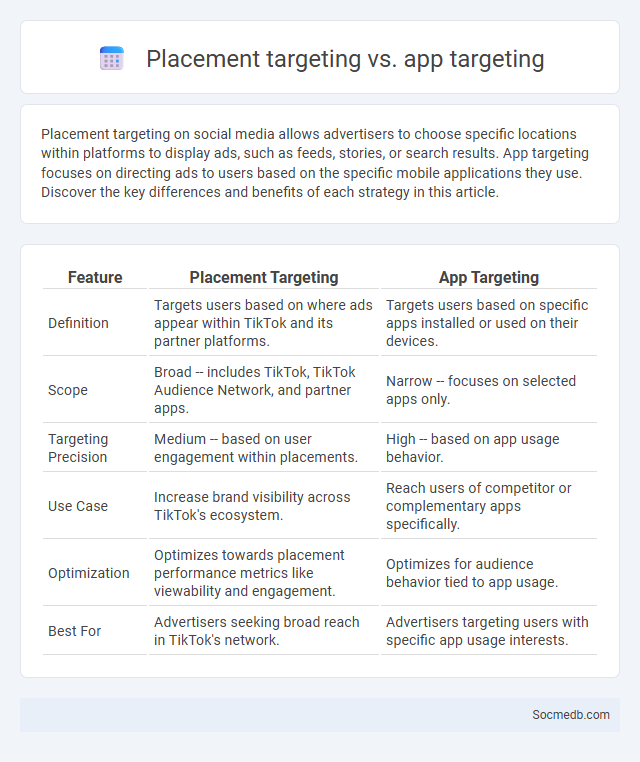
Photo illustration: Placement targeting vs App targeting
Placement targeting on social media allows advertisers to choose specific locations within platforms to display ads, such as feeds, stories, or search results. App targeting focuses on directing ads to users based on the specific mobile applications they use. Discover the key differences and benefits of each strategy in this article.
Table of Comparison
| Feature | Placement Targeting | App Targeting |
|---|---|---|
| Definition | Targets users based on where ads appear within TikTok and its partner platforms. | Targets users based on specific apps installed or used on their devices. |
| Scope | Broad -- includes TikTok, TikTok Audience Network, and partner apps. | Narrow -- focuses on selected apps only. |
| Targeting Precision | Medium -- based on user engagement within placements. | High -- based on app usage behavior. |
| Use Case | Increase brand visibility across TikTok's ecosystem. | Reach users of competitor or complementary apps specifically. |
| Optimization | Optimizes towards placement performance metrics like viewability and engagement. | Optimizes for audience behavior tied to app usage. |
| Best For | Advertisers seeking broad reach in TikTok's network. | Advertisers targeting users with specific app usage interests. |
Introduction to Digital Ad Targeting
Digital ad targeting leverages algorithms and user data to deliver personalized advertisements across social media platforms, enhancing engagement and conversion rates. By analyzing demographics, interests, and online behavior, marketers can precisely reach your desired audience with relevant content. This targeted approach maximizes advertising ROI and improves the overall effectiveness of social media campaigns.
What is Placement Targeting?
Placement targeting in social media advertising allows marketers to select specific locations where their ads appear, such as particular websites, apps, or within certain sections of a social platform. This strategy enhances ad relevance and reach by directing content to audiences in preferred digital environments, optimizing engagement and conversion rates. Platforms like Facebook, Instagram, and YouTube offer precise placement targeting options, enabling advertisers to maximize return on ad spend.
What is App Targeting?
App targeting is a digital marketing strategy that focuses on delivering ads to users based on the specific mobile applications they use. By analyzing app usage patterns, advertisers can reach highly relevant audiences, increasing the likelihood of engagement and conversion. Your campaigns become more efficient by targeting users within apps that align closely with your product or service niche.
What is Audience Targeting?
Audience targeting is a strategic approach in social media marketing that involves identifying and reaching specific groups of users based on demographics, interests, behaviors, and online activity. By leveraging data analytics and platform algorithms, brands can deliver personalized content and advertisements that resonate with the most relevant consumers, increasing engagement and conversion rates. Effective audience targeting improves ad spend efficiency and enhances user experience by providing tailored messages to a precisely defined market segment.
Key Differences Between Placement, App, and Audience Targeting
Placement targeting controls where ads appear within specific social media platforms, such as feeds, stories, or in-stream videos, optimizing ad visibility. App targeting narrows down the ad delivery to users of particular applications, allowing advertisers to engage audiences based on app usage patterns and behaviors. Audience targeting focuses on demographic, psychographic, and behavioral data to pinpoint specific groups, ensuring ads reach users most likely to engage or convert.
Advantages of Placement Targeting
Placement targeting on social media allows advertisers to reach specific audiences by choosing exact locations such as websites, apps, or devices where their ads appear. This precision enhances ad relevance, resulting in higher engagement rates and better conversion performance. Advertisers gain more control over budget allocation, ensuring investment optimization by focusing on high-performing placements.
Benefits and Limitations of App Targeting
App targeting on social media allows you to reach highly specific audiences based on their app usage, enhancing ad relevance and engagement rates by delivering personalized content. This method improves campaign efficiency by focusing on users already interested in related apps, thereby increasing conversion potential. However, limitations include privacy concerns and data restrictions, which may reduce the accuracy of targeting and limit access to certain user demographics.
Audience Targeting: Strengths and Challenges
Audience targeting on social media enables precise segmentation using demographics, interests, and online behavior, maximizing ad relevance and engagement rates. Platforms like Facebook and Instagram offer advanced tools to reach niche markets, improving conversion outcomes through personalized content delivery. Challenges include data privacy concerns and evolving algorithms, which can limit targeting accuracy and increase ad costs.
Choosing the Right Targeting Strategy for Your Campaign
Selecting the right targeting strategy for your social media campaign requires analyzing audience demographics, interests, and behaviors on platforms like Facebook, Instagram, and LinkedIn. Utilizing advanced tools such as Facebook Ads Manager allows precise segmentation based on age, location, and purchase intent, increasing campaign relevance and ROI. Continuous monitoring and A/B testing of targeting parameters ensure optimization and effective engagement with your ideal customer profile.
Best Practices for Optimizing Targeting Approaches
Effective social media targeting relies on leveraging data analytics to identify your ideal audience segments based on demographics, interests, and online behavior. You should continuously test and refine your targeting criteria using A/B testing and audience insights to enhance engagement and conversion rates. Incorporating lookalike audiences and retargeting strategies further maximizes ad relevance and ROI.
 socmedb.com
socmedb.com